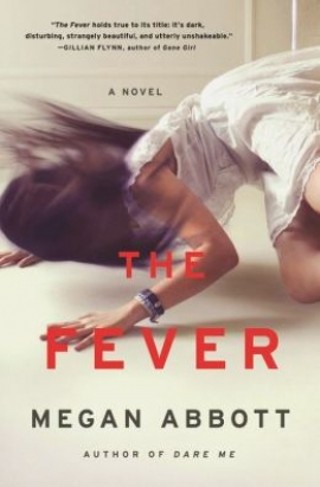Lit-urday: The Fever
Megan Abbott novel outfits high schoolers in a fetching shade of noir
By Amy Kamp, 11:00AM, Sat. Jul. 5, 2014

It's been a long week, and now you deserve to have one day when you can curl up with a good book – let's call it Lit-urday. Perhaps you could use something to quicken your pulse with a long walk down a shadowy hallway. Megan Abbott has such a hallway – in a high school, of all places – in a dense suspenser part Crucible, part Play It As It Lays.
The Fever
by Megan Abbott
Little, Brown; 303 pp.; $26
Heavy is the hand that would write about American suburban teenage girls. After all, what’s left to be said, when the subject’s so well-worn? Yet Megan Abbott continues to successfully mine the territory: The Fever, like her recent novels Dare Me and The End of Everything, uses the “high drama of noir” to explore adolescent passion and anxiety.
In 2011, over a dozen teenage girls in Le Roy, N.Y., started exhibiting symptoms that resembled Tourette’s, sparking concern that quickly turned to paranoia. After EPA testing ruled out environmental contaminants, most experts agreed that the cause was a combination of conversion disorder and mass psychogenic illness - one case of Tourette’s had led the other girls to be afflicted with its symptoms but not the underlying syndrome.
The Fever takes its inspiration from that incident, but very loosely. It’s a jumping-off point for Abbott to ruminate on sex, beauty, horror, family, and female friendship. Deenie Nash is a high school junior, innocent, sweet, and studious. As the book begins, she’s just lost her virginity to the sweaty, sexy, sleazy senior she works with at Pizza House and is trying to keep it a secret from everyone, including her best friends, Lise and Gabby. Lise is light-haired, “so pretty it sometimes hurt to look at her,” bubbly, and boy-crazy; Gabby is “heavy-haired,” “the one all the girls puppy-dogged after school,” with a “meant-for-college-guys gravitas.”
Each of the girls’ families is unhappy in its own way. Deenie’s mother has left town, having divorced her father after having first an affair and then a miscarriage. Lise’s mother seems to spend most of her time worrying about Lise, trying to keep an eye on her. And Gabby’s mother’s face and neck bear scars from when her ex-husband, high on cocaine, attacked her with a claw hammer: “Gabby carried the glamour of experience like a dark queen with a bloody train trailing behind her.” Gabby’s other best friend, witchy Skye, lives with her aunt, who apparently sees nothing wrong with Skye having a 26-year-old boyfriend.
The day after Deenie’s brief assignation, Lise has a seizure in class, “[h]er head twisting, slamming into the tiles, her bright red face turned up, mouth teeming with froth.” After Lise is rushed to the hospital, first Gabby and then other girls start exhibiting seizurelike tics. Lise’s mother thinks they’ve been poisoned by the HPV vaccine the school recommended for all the female students. Others blame the town’s “dead lake,” which is so toxic it can no longer support any life other than sinister, fluorescent algae. Abbott is a marvelously self-assured writer, able to wring every last bit of suspense and dread from just about any situation, including getting a shot at the doctor’s office. Naturally, in her hands, the premise of a mysterious, unexplained illness exemplifies the everyday uncanny: “looking down at Lise, lips stretched wide, Deenie thought, for one second, that she saw something hanging inside Lise’s mouth, something black, like a bat flapping.” Later, after seeing Lise comatose at the hospital, she becomes convinced that the person lying there isn’t Lise; “this wasn’t either girl, or any girl.”
Unlike Gillian Flynn, to whom she’s often compared, and whose praise is prominently featured on the covers of both Dare Me and The Fever, Abbott shows great sensitivity to her characters. Flynn is a master of tight, twisty plots, but they’re populated with marionettes controlled by a mean-spirited puppeteer instead of real people. Abbott, on the other hand, lets her characters be both gentle and sensitive, and selfish and cruel, just like anyone alive. Written in the third person, The Fever unfolds from the alternating perspective of Deenie, her hot jock brother Eli, and her father Tom, a popular science teacher at the school. Each is allowed a full inner life and never descends into caricature. Additionally, Abbott perfectly captures the overwhelming emotions of adolescent female friendship, its complex combination of love, possessiveness, rivalry, and viciousness.
While many writers have flourished under the constraints of genre – Chandler, Highsmith, Le Carre, and Natsuo Kirino are some excellent examples – one can’t help but wonder if Abbott is merely constrained at this point. She’s obviously deeply fascinated by noir - not only were her first four novels throwbacks to its midcentury, L.A. heyday, she also wrote a nonfiction analysis of the genre, 2002’s The Street Was Mine: White Masculinity in Hardboiled Fiction and Film Noir. But for all of her skill at setting the mood, she seems less than interested in creating a compelling resolution to The Fever’s central mystery, yet also unwilling to leave loose ends.
Abbott’s previous novel, Dare Me, was self-consciously (but enjoyably) hard-boiled, with a teenage cheerleader protagonist who talks like an erudite, middle-aged alumna of the School of Hard Knocks: “I was never one of those mask-faced teenagers, gum lodged in mouth corner, eyes rolling and long sighs. I was never that girl at all. But I knew those girls. And when she came, I watched all their masks peel away.” In contrast, The Fever is quieter and more realistic. Deenie and Lise can be heartbreakingly guileless, a different species than the “glitter-gritted” girls of Dare Me. But at times, Abbott’s desire to make her point compromises verisimilitude. Lines like “All of the sudden she was so goddamned pretty. Some of us have been pretty forever” would fit perfectly within Dare Me, but are jarring coming from the mouth of the girl who earlier described Lise’s seizure as a “grand male.” However, for the most part, everything coheres to form a dense, thoughtful yet suspenseful read.
The Fever is in many ways reminiscent of Joan Didion’s early fiction, with its focus on ominous atmosphere and polished tone. Like Maria in Didion’s Play It As It Lays, these girls know what makes Iago evil.
A note to readers: Bold and uncensored, The Austin Chronicle has been Austin’s independent news source for over 40 years, expressing the community’s political and environmental concerns and supporting its active cultural scene. Now more than ever, we need your support to continue supplying Austin with independent, free press. If real news is important to you, please consider making a donation of $5, $10 or whatever you can afford, to help keep our journalism on stands.
The Fever, Megan Abbott, Gillian Flynn, Joan Didion







